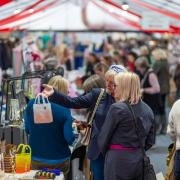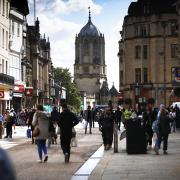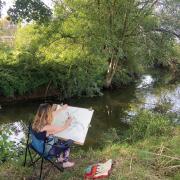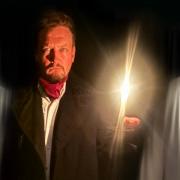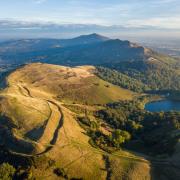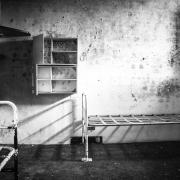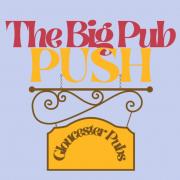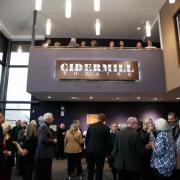‘A shepherd he sat on the high chalk downs by the slopes of Hackpen Hill, He grazed his sheep to the lark’s clear sound and he fiddled ’til he’d fiddled his fill.’ C Smith (2020)
To me, the Wiltshire downland in the very south of our region is one of the most magical landscapes I can imagine, with its scoured round hills, chalk meadows, leaping hares and soaring red kites. This walk takes us just south of Swindon on the road to Avebury. When you see the white horse cut into the chalk, take the road up Fiddler’s Hill – we’re going for a walk along the Ridgeway at Hackpen Hill. This isn’t an ancient white horse like that at Uffington, which may be more than 3000 years old. The Hackpen horse was likely cut in 1838 to commemorate Queen Victoria’s coronation by Harry Eatwell, from Broad Hinton, and a pub landlord, one of nine late-17th to 20th century white horses in Wiltshire. And why not? If you’re doing this walk before the harvest you might see something strange as you walk or drive up the hill, too, as the area around here near Avebury is crop circle central!

To start the walk, set out up to the ridgeline to walk to the right along the Ridgeway, an ancient trackway that stretches from Aylesbury to Avebury. It links to other ancient routes like the Wessex Ridgeway and the Icknield Way, linking the south coast to the North Sea in East Anglia. You’re walking the same paths as those who built Avebury and, later, Stonehenge, as we will see. Hackpen Hill was considered an uncanny place for many years before the chalk horse was carved or the crop circles appeared. It’s no surprise that’s an enchanted landscape, but it’s not just humans, hares and sheep that tread the path – the fairies are active up here, too.
As you follow the Ridgeway, you’ll see small tumuli on the hill overlooking the road. These are Bronze Age saucer and bowl barrows, placed there, perhaps, so the dead could guard or mark the territory of the living. Even long after, everyone knew these were places of the dead. Farmers often ploughed them over, finding bones and sometimes treasure. Antiquarian John Aubrey recorded in the 17th century that on Hackpen Hill ‘in a barrow … after digging, was found at thigh-bone of a man and several urns’, probably a Bronze Age ‘beaker’ burial, from around 2500-1700 BC. Many people at that time, not knowing about the Stone Age or the Bronze Age, believed that what they were finding were the remains of much later Saxons and Vikings. In some cases, of course, this was true – on Hackpen Hill in the late 19th century Canon Greenwell, ‘a prolific excavator of barrows’, found evidence of the reuse of a barrow, finding a later Saxon inhumation with an iron spear laid over a Bronze Age cremation burial containing a bronze dagger.

What if the barrows were something else? What if they were places of the fairy? There’s always been an uncertainty about the fairies. Are they spirits, perhaps angels who fell from heaven with Lucifer, but landed on earth rather than in hell? Are they nature spirits like classical dryads? Or are they the spirits of the dead? It’s no surprise that burial mounds have long been seen as fairy places, places where the fairies come in and out of our world from their one underground. Where the Ridgway goes around a mound with a tree atop it, take the path down the hill and follow it in a loop back up to the Ridgeway again. If you look carefully, you’ll numerous barrows.
Imagine yourself here at night. The moon is full, the shadows shifting. John Aubrey records that the old folk believed that the fairies would come out of the hill at night and steal away human children and leave their own changelings in their place. He tells of a white hart led away on a merry dance all the way to Devizes, and that a shepherd from Winterbourne Bassett down in the valley was taken by the fairies into a strange underground realm in the hill. He was led to a place where he heard beautiful music played on lutes and viols, instruments already old-fashioned by the late 17th century when Aubrey was writing. Perhaps there was fairy dancing, too. Whatever, happened, after this strange adventure, the shepherd was never the same again, as people who have strayed into the world of the fairies – or the dead – are often not.

It’s no surprise that the hill below the white horse is called Fiddler’s Hill – it was often fiddler’s who strayed into underground tunnels, the sound of the fiddle heard by those above until … it stops, and the fiddler is never seen again. Those legends inspired me to make my shepherd in my retelling in Wiltshire Folk Tales a fiddler, searching for his lost sheep. In my tale, he goes back into the hill to play once ore for the fairies and dance with them. The quote at the top of this article comes from singer-songwriter Chantelle Smith’s song based on my retelling of the story of the shepherd. It was composed for the Swindon Lost Words. Not co-incidentally, she’s been a shepherd on Hackpen Hill, caring for her flock in all the weathers the windy hill can throw at you!
Once back on the Ridgeway, walk down until you meet the Wessex Ridgeway, which has come up from Lyme Regis in Dorset and turn right. You’ll cross a horse-racing gallops, one of many on the Downs, and then as you go past first a copse, the path forks. Take the left-hand path, then by the wall of another, smaller cluster of trees, take the left-hand path. You will find yourself in a hollow of stones! These are the Grey Wethers. They are named after the sheep they resemble, which have grazed these hills since time immemorial. Chantelle’s Aureus Flocklet is only one of the most recent examples! The stones are sarsen stones, the very same kind used to build the great triliths at Stonehenge. It’s said that the Devil carried them there. Old Nick has many connections with the area. Not far from here is the Devil’s Den at Manton, a dolmen where it’s said that even the Devil can’t move the stone, even with four white oxen pulling at it – which is a shame, as it’s a route down to hell that he can no longer access! But at least he can get a drink there – as any water poured into the cup marks on the capstone will be drunk by the Fiend.

Continue along the path until you reach a T-junction in Totterdown Wood and turn left, heading back along White Horse Way to the Ridgeway. Just before you get back on the Ridgeway, you pass a pond, and to the right of the path, there was once a medieval enclosure, known as the ‘old chapel’, that that housed a long barrow, now also lost to the plough. These much older barrows date back to the Neolithic, or New Stone Age, and can be more than 5000 years old. Aubrey recorded that the people of Wiltshire, familiar with these vast monuments to the dead, thought that they were the graves of giants – although sadly no record of giants walking the Ridgeway has been recorded, not even to ride the giant white horse we’ve come back to at the car park!
ESSENTIALS
Distance: 7 miles.
Duration: 3.5 hours.
Level: Easy, mostly on the ridgeways, with some rough ground and pathways
Parking: Hackpen Hill carpark
Toilets and refreshments: This route doesn’t pass anywhere, but nearest place is The Winterbourne, Winterbourne Bassett
Transport links: Stagecoach bus 49 from Swindon/Devizes stops at the Winterbourne Bassett turn and there is a permissive track that takes you up to the Ridgeway a little further along than the carpark.
Further reading: Wiltshire Folk Tales, by Kirsty Hartsiotis
LINKS
Route: gb.mapometer.com/walking/route_5466654.html
The Ridgeway: nationaltrail.co.uk/en_GB/trails/the-ridgeway
Chantelle Smith: chantellesmith.co.uk
Aureus Flocklet: aureusflocklet.wordpress.com
Kirsty Hartsiotis is based in Stroud and available as a storyteller and speaker. She is an Accredited Arts Society lecturer. Her books include Wiltshire Folk Tales and (with Anthony Nanson) Gloucestershire Ghost Tales and Gloucestershire Folk Tales for Children. She is also the curator of decorative art at a Gloucestershire museum.




